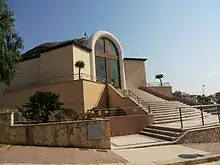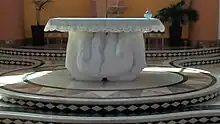Gesù Cristo Redentore, Alcamo
Gesù Cristo Redentore ("Jesus Christ the Redeemer") is a Catholic church in Alcamo, in the province of Trapani, Italy.
| Gesù Cristo Redentore | |
|---|---|
Chiesa di Gesù Cristo Redentore | |
 The façade | |
| Religion | |
| Affiliation | Catholic |
| Province | province of Trapani |
| Region | Sicily |
| Rite | Catholic |
| Patron | Gesù Cristo Redentore |
| Year consecrated | 2008 |
| Location | |
| Location | Alcamo, province of Trapani, Italy |
| Municipality | Alcamo |
| State | Italy |
| Territory | Alcamo |
| Geographic coordinates | 37°58′12″N 12°57′09″E |
| Architecture | |
| Architect(s) | Vincenzo Calvaruso |
| Type | modern |
| Funded by | Don Benedetto Cottone |
| Groundbreaking | 2002 |
Description
.jpg.webp)
In the planning of the overall parish "Gesù Cristo Redentore", they have followed the guidelines recommended by the Conferenza Episcopale Italiana (Italian Episcopal Conference) in 1993.[1]
The church, in a central position in the district of "Sant’Anna" (in the area of Via Kennedy), is an example of how the use of glued laminated timber allows linking functionality and beauty; it is larger than 600 square metres and, in accordance with the regulations on the removing of architectural barriers, it has a sloping floor towards the Presbytery (architecture), with a declivity which allows optimal participation to the believers during the liturgical functions.[2]
It is made up of the Presbytery, located in the apse, with a step higher than the hall, the Ambon and the sacramental area, with a wooden dome (in glued laminated timber) above it; the floor here is realized with polychrome marbles and so believers can differentiate the meaning of the different liturgical functions;[2] a central nave, corresponding with the hall, and with about 600 seats, and two aisles for the coming in and out of people, and for the processional route during the functions; the parvis which permits the outdoor celebrations with great participation of believers, thanks to its position on the top of the staircases.[2]
